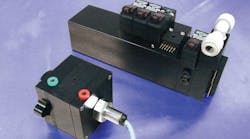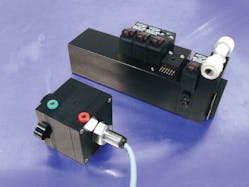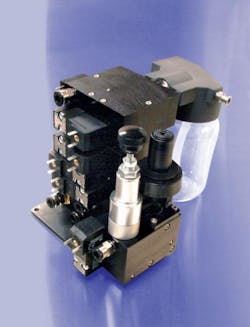Pneumatics is routinely used in medical devices due to the safety and cleanliness of compressed air. Applications range from driving small and simple handheld tools to powering large and complex operating-room equipment.
Suppliers like Pneumadyne, Plymouth, Minn., make a range of miniature pneumatic valves, fittings, and controls for a wide variety of medical hardware. The company’s standard components are generally the first choice when medical-device manufacturers are assembling systems — provided they suit the application requirements. Benefits include wide availability, quick delivery, and economical pricing. The range of standard offerings includes:
• Directional-control valves in a variety of porting sizes and configurations.
• Miniature regulators that precisely control air pressure and are suited for limited-space applications.
• Stainless-steel valves and fittings that withstand corrosive environments.
• Oxygen-clean pneumatic valves and fittings that are free of particulates, oil, grease, and other contaminants.
Often, however, off-the-shelf products don’t quite meet an OEM’s requirements when integrating pneumatics into medical equipment. For that reason, custom-designed components and controls are found in a wide variety of medical devices.
In many cases, Pneumadyne engineers will consolidate a number of components into a single, custom-built manifold system or valve block — without compromising performance. Integrating components offers numerous benefits, such as eliminating potential leak points, reducing the opportunity for contamination, and simplifying system assembly. Last but not least, it improves the appearance of a circuit.
Here’s a look at two custom products that the company recently developed.
Valve assembly
A medical-equipment manufacturer asked Pneumadyne’s engineers to evaluate a new trauma device that was under development. The medical OEM’s design team had prototyped the pneumatic system using discrete components from various manufacturers. But the design needed several improvements.
Among the application requirements:
• The pneumatic circuit had to fit inside the customer’s existing equipment housing.
• Decrease the time required to assemble and install the circuit.
• Meet specific flow and pressure requirements at a pump pressure of 7 psi.
• Provide pressure-sensing feedback to the host computer.
• Eliminate potential leak points.
The Pneumadyne’s engineering team redesigned the circuit into a block assembly that eliminated 25 individual components. The device included three pressure transducers that provide an electronic interface for the measurement of system pressure; push-to-connect fittings that simplify tubing connections and system installation; a built-in, quick-reaction air reservoir; and four solenoid valves to control cylinders and other functions within the circuit.
The design also included a custom, double-acting rolling diaphragm cylinder with integral position feedback. The cylinder had to function without “stiction” or hesitation at a pressure differential of only 1.5 psi.
The block assembly met the application requirements, eliminated numerous potential leak points, and reduced the amount of time needed to plumb the pneumatic circuit.
3-in-1 manifold
Another equipment manufacturer faced the challenge of reducing the size of a pneumatic system to fit the space constraints imposed by operating-room equipment that had already been designed. Complicating matters, several components within the device had to withstand autoclaving sterilization.
Pneumadyne engineers sought to combine the functions of several individual operatory devices into a single package. The goal was to reduce the space needed for three separate pneumatic circuits while meeting specific flow and pressure demands.
To solve the problem, the engineers developed an integrated manifold block that houses the three separate circuits and meets the space constraints of the customer’s equipment. This multifunction assembly, in turn, let the customer replace several devices within the operatory.
The design included:
• A precision regulator preset at 2 psi controls pressure in one circuit.
• A regulator preset at 7.5 psi supplies pressure to a water chamber.
• A valve housed within a plastic cap controls water flow.
• Four pressure transducers measure system flow and pressure.
• Five oxygen-cleaned solenoid valves.
• Push-to-connect fittings that ease tubing connection and system installation.
• Two relief valves to vent overpressure.
Special tests ensured that the device met the required flow and pressure specifications.
For more information on Pneumadyne’s pneumatic products, visit www.pneumadyne.com.



